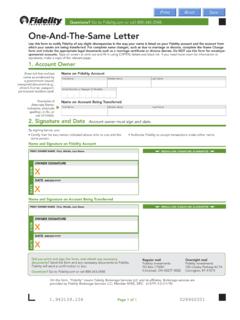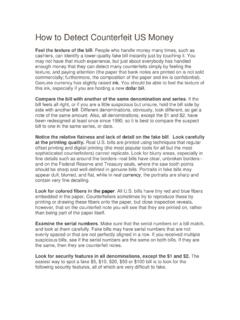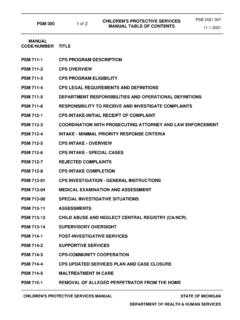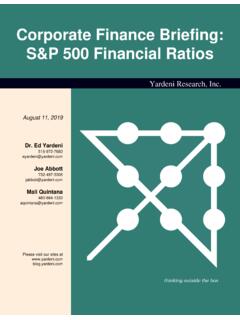Transcription of The future of retail banking The hyper-personalisation ...
1 The future of retail banking The hyper-personalisation imperative GO. November 2020. Contents Foreword 03. Introduction 04. Why must banks adopt hyper-personalisation ? 06. What obstacles are preventing banks from 11. adopting hyper-personalisation ? How can banks overcome these obstacles 16. to adopt hyper-personalisation ? Conclusion 22. References 23. Contacts 24. The future of retail banking | The hyper-personalisation imperative Foreword In this report, we are addressing In a collaborative research effort with the European Investment This report is of particular relevance to banks' boards Bank (EIB), the Global Alliance for banking on Values (GABV), and senior executives as well as to strategy, marketing, the medium term challenge around and KKS Advisors, we showed how commercial banks with and digital specialists.
2 We look forward to discussing its banks' business model. As such, good performance on material environmental, social and findings with you. governance (ESG) issues financially outperform those with we believe that hyper-personalisation less good is an imperative for banks, enabling In this report, we are addressing the medium term challenge them to respond to customers' around banks' business model. We believe that hyper- manifest and latent needs. personalisation is an imperative for banks, enabling them to respond to customers' manifest and latent needs. In so doing, hyper-personalisation will differentiate their brand, boost their revenues, and improve financial inclusion. To achieve these This challenge has been exacerbated by COVID-19, as central objectives, we outline those building-blocks that banks must have banks around the world have scrambled to cut rates.
3 Over the data science, behavioural science, and ethnographic research medium term, banks vertically-integrated business model faces capabilities and how these can be applied to innovate, in terms disruption, as evolving customer needs are increasingly being of both product functionality and product design. Richard Kibble Margaret Doyle met by innovative newcomers that are picking off some of banks'. Partner, UK banking Leader Partner, Chief Insights Officer most profitable lines of business, like payments and foreign In particular, we believe that banks must become more like Financial Services and Real Estate exchange. Over the long term, banks need to ensure that their corporates. In the past, banks' success rested on mastering a purpose meets the expectations of a range of stakeholders well small number of capabilities, namely credit allocation, capital beyond shareholders who have held sway since the 1980s.
4 Management and operations. There was little differentiation between various banks' product offerings, and limited Deloitte has addressed both near- and long-term challenges in understanding of customer needs. We believe that, in future , recent research. Following the spring lockdowns across Europe, banks will have to understand customers much better, and to we explored how European banks can respond, recover and develop the marketing and branding skills that would enable thrive again, by outlining different routes to rebuild them to foster an emotional connection with customers. These competences are commonplace in other sectors, such as fast- moving consumer goods and retail industries. 03. The future of retail banking | The hyper-personalisation imperative Introduction The advent of the digital age is Nonetheless, progress in other industries ranging from retail ( , tailored products), transport ( , ride hailing), inextricably linked with tailor-made hospitality ( , home-sharing platforms), etc.
5 Alongside hyper-personalisation can be defined offerings that deliver personalised advances in FinTech are contributing to redefine customers' as harnessing real-time data to expectations of banking . It is, therefore, unsurprising that services, products and pricing to 51% of consumers surveyed by Salesforce expect that banks generate insights by using behavioural customers. Over the past decade, will anticipate their needs and make relevant suggestions science and data science to deliver before they even make banks have deployed personalised services, products and pricing that offerings ( , micro-segmentation, As a result of the advances in other industries, banks are increasingly expected to deliver hyper-personalisation . are context-specific and relevant to packaged products and services) hyper-personalisation can be defined as using real-time data customers' manifest and latent needs.
6 To increase customer loyalty and to generate insights by using behavioural science and data science to deliver services, products and pricing that are maintain their competitive context-specific and relevant to customers' manifest and latent needs ( those needs which, due to a lack of information or availability of a product or service, cannot be satisfied). These insights are garnered using Artificial Intelligence to analyse data. This hyper-personalisation is the software equivalent of the mass customisation that emerge from supply chain re-engineering in the 1990s. HSBC foresees a new standard of customer service: in the future , customers will increasingly be able to expect a highly-personalised service determined by their individual requirements, instead of based around a set of savings, borrowing and investment products, each with their own sales and servicing characteristics.
7 4. i Granular segmentation approach that leads to highly personalised experiences that compel customers to action. 04. The future of retail banking | The hyper-personalisation imperative Smart devices, rapidly-evolving customer experience (CX) To further evidence these, results from a survey of more and real-time data processing are not the only factors creating than 2,000 respondents have been included. Lastly, the hyper-personalisation imperative for banks. Governmental and regulatory expectations have translated into a need for Part 3 outlines Deloitte's recommendations for overcoming banks to play a fuller role in meeting society's financial needs. these obstacles. In particular, banks are increasingly expected to improve financial That is, it outlines which building-blocks banks must have.
8 Close to 35% of adults in the UK are at risk of financial data scienceii, behavioural scienceiii, and ethnographic research exclusion, meaning that they do not have sufficient access to capabilitiesiv and how these can be applied to innovate, in terms mainstream financial services and The factors that of both product functionality and product design. By adopting drive financial exclusion are both demand-driven (influenced hyper-personalisation , banks will respond to customers' manifest by customers' choices) and supply-driven (influenced by banks'. and latent needs and, in doing so, will differentiate their brand, offering). The beauty of hyper-personalisation is that it can be multiply their revenues and increase financial inclusion. deployed to address both. In this report we focus on what banks need to do in order to truly meet their banked and underbanked customers' manifest and latent needs.
9 But we recognise that the imperative of truly Smart devices, rapidly-evolving embracing hyper-personalisation is by no means confined to banks: all financial services sectors have to. customer experience (CX) and real-time data processing are not This report examines hyper-personalisation in banking from a behavioural science perspective. the only factors creating the hyper- It is divided into three parts: personalisation imperative for banks. Part 1 sets out why hyper-personalisation is imperative for banks. Part 2 sets out the obstacles faced by banks in adopting hyper-personalisation . ii Inter-disciplinary field that uses scientific methods, processes, algorithms and systems to extract knowledge and insights from data. iii A branch of science (such as psychology, sociology, or anthropology) that deals primarily with human action and often seeks to generalize about human behavior in society.
10 Iv Qualitative method where researchers observe and/or interact with the participant in their real-life environment. 05. The future of retail banking | The hyper-personalisation imperative Why must banks adopt hyper-personalisation ? 06. The future of retail banking | The hyper-personalisation imperative The brand differentiation argument We believe that hyper-personalisation Smart devices, by gathering and storing real-time data, are enabling firms to improve customer service and customer is an imperative, not an option, in a engagement. In terms of customer service, firms can advertise digital economy. Indeed, as various products based on a customer's real-world context ( , offering products related to those previously bought). In terms industries adopt technology as of customer engagement, firms can now interact with their their business, rather than in their customers beyond the point of sale to respond to and even anticipate their customers' latent needs.














